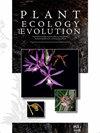阿尔及利亚本土树木区系清单:多样性、分布和保护
IF 1.3
4区 生物学
Q3 PLANT SCIENCES
引用次数: 4
摘要
背景和目标——树木是世界上许多生态系统的重要组成部分。了解它们的多样性和地理分布具有重要的理论和实践意义。本文旨在提供阿尔及利亚本土树木分类群的第一份综合清单。材料和方法——检查表基于对公布数据的分析,并通过自己的实地观察进行了改进。对阿尔及利亚树木区系的多样性、特有性、栖息地和分布等方面的分类丰富度、生命形式和合唱谱进行了统计分析。介绍了世界自然保护联盟之后的保护状况和国家层面的保护状况。关键结果-该清单包括阿尔及利亚目前已知的120个本土树木分类群,包括106个物种、一个杂交物种和13个亚种,隶属于35科63属。四个物种最丰富的科是蔷薇科(13个属)、蚕豆科(12个属),杨柳科(9个属)和罗望子科(9种属)。最丰富的属是罗望子属(9种),其次是栎属(6种中的7个分类群)。我们发现,树木通常是单茎的(45%),并且是小型或中型的。地中海元素占主导地位(46%),其次是撒哈拉阿拉伯元素(17%)、广泛分布元素(15%)和欧洲元素(12%)。此外,11%的树木分类群是特有种或亚特有种。分类群数量最多(71%)出现在Tellian地区,而数量最少(36%)出现在撒哈拉地区。只有9个分类群被认为受到威胁或接近威胁,而36个分类群尚未评估。这项分析突出了33个具有遗传价值的分类群,包括地方学和范围限制。在这些分类群中,只有18个受到国家立法的保护。结论——这项工作表明,阿尔及利亚发现了相对丰富的树木区系。它旨在作为管理树种多样性的工具。一些树木分类群需要采取适当的措施进行原位保护,这是一个具有挑战性但值得追求的目标。本文章由计算机程序翻译,如有差异,请以英文原文为准。
Checklist of the native tree flora of Algeria: diversity, distribution, and conservation
Background and aims – Trees represent an important component of many ecosystems of the world. The knowledge of their diversity and geographic distribution is of great theoretical and practical importance. This paper aims to provide the first comprehensive checklist of native tree taxa in Algeria. Material and methods – The checklist was based on the analysis of published data and has been improved with own field observations. Statistical analysis has been performed on the taxonomic richness, life forms, and chorological spectra in terms of diversity, endemism, habitats, and distribution of the tree flora in Algeria. The conservation status following IUCN and the protection status at national level have been presented.Key results – The checklist comprises 120 native tree taxa currently known in Algeria, including 106 species, one hybrid species, and 13 subspecies, belonging to 63 genera and 35 families. The four most species-rich families are Rosaceae (13 spp.), Fabaceae (12 spp.), Salicaceae (9 spp.), and Tamaricaceae (9 spp.). The richest genus is Tamarix (9 spp.), followed by Quercus (7 taxa in 6 spp.). We found that trees are more often single-stemmed (45%), and are small or medium-sized. Mediterranean element is dominant (46%), followed by Saharo-arabic (17%), wide distribution element (15%), and European elements (12%). Furthermore, 11% of all tree taxa are endemics or subendemics. The highest number of taxa (71%) is found in the Tellian area, whereas the lowest number (36%) occurs in the Saharan area. Only nine taxa are considered to be threatened or near threatened, while 36 taxa are yet not assessed. This analysis highlights 33 taxa with patrimonial value, both endemics and range-restricted. Out of these taxa, only 18 are protected by national legislation. Conclusion – This work shows that a relatively rich tree flora is found in Algeria. It aims to be used as a tool for managing tree species diversity. Some of the tree taxa need appropriate measures for their in situ conservation, a challenging but worth pursuing target.
求助全文
通过发布文献求助,成功后即可免费获取论文全文。
去求助
来源期刊

Plant Ecology and Evolution
PLANT SCIENCES-
CiteScore
2.20
自引率
9.10%
发文量
27
审稿时长
>12 weeks
期刊介绍:
Plant Ecology and Evolution is an international peer-reviewed journal devoted to ecology, phylogenetics and systematics of all ‘plant’ groups in the traditional sense (including algae, cyanobacteria, fungi, myxomycetes), also covering related fields.
The journal is published by Meise Botanic Garden and the Royal Botanical Society of Belgium.
 求助内容:
求助内容: 应助结果提醒方式:
应助结果提醒方式:


